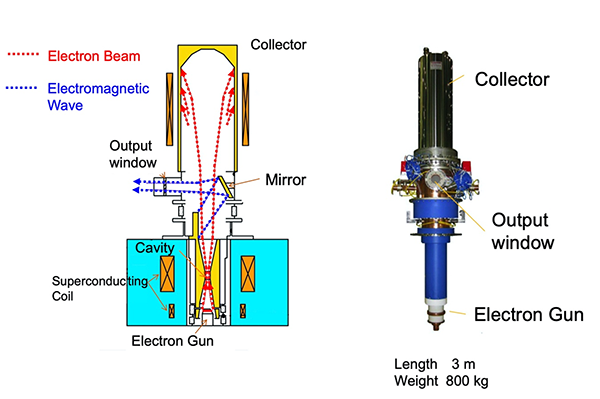HOME > Research Activities > Research Updates >
Design developing research of gyrotron
To achieve nuclear fusion power, it is necessary to heat plasma to the extreme high temperature of more than one hundred million degrees. One of the means for heating plasma is a method in which strong electromagnetic waves are launched into plasma. Plasma is the state in which ions and electrons are separated and the electrons in the plasma confined in the magnetic fields gyrate around the magnetic fields. When the same frequency electromagnetic wave as the gyration frequency is launched into plasma, the energy of the electromagnetic wave is given to the electrons, the energy of the electron gyration increases and the electrons are heated. And, even at the second and third time of the electron gyrofrequency, the electromagnetic wave can heat electrons. In addition, when the heated electrons conflict with ions in the plasma, the ion temperature rises and the entire plasma is heated. In the Large Helical Device (LHD), a plasma experiment is carried out by such a heating method and incident electromagnetic waves are generated with the device called the "Gyrotron" which is similar to a large-scale household microwave oven. This time, we introduce the mechanism of the gyrotron and the design development research of a new gyrotron aiming for a high performance heating method.
A gyrotron generates electromagnetic waves with the use of the energy of electrons gyrating in the magnetic field. In short, the gyrotron uses the reverse process of electron heating by the electromagnetic wave described above. The gyrotron of the LHD is an immense vacuum tube approximately three meters across and whose weight is approximately 800 kilograms. The electric gun which generates the electric beam in the lower part of the gyrotron and the cavity resonator beyond the gyrotron are installed. The gyrotron is inserted in the super conductor magnet generating the strong magnetic fields. For generating strong electromagnetic waves, at first, we draw electron beams with high power under high voltage surge. Extracted electrons enter into the cavity resonator while gyrating under the influence of the magnetic field by the superconducting magnet. The cavity resonator plays a role such as a resonance box under a tuning fork and resonates with a specific frequency of the electromagnetic wave to strengthen the electromagnetic wave. Here, a part of the energy of the electron gyrations is transformed to the energy of the electromagnetic wave and the electromagnetic wave is generated. The electromagnetic waves generated by this method are collected by using the reflection of the mirrors in the gyrotron, and finally are taken away from the output window to the outside.
A gyrotron has only one frequency that can generate the strong electromagnetic wave. Because the electrons in the plasma gyrate approximately 77 billion times each second in the LHD, three gyrotrons generating electromagnetic waves of 77 GHz(G, which means one billion) and two gyrotrons generating an electromagnetic wave of 154 GHz , which is twice those set in the LHD. These gyrotrons heat the electrons in the plasma.
For higher performance of the plasma heating method with the gyrotron, recently, much attention has been paid to research that generates a particularly strong electromagnetic wave selected from multiple frequencies from one gyrotron. Therefore, NIFS in collaboration research with Tsukuba University is promoting a design development research of a gyrotron that can generate 154 GHz and 116 GHZ alternatively with the change of magnetic fields of the superconducting magnet. When the strength of the magnetic fields changes, the gyrofrequency of the electrons changes, and the frequency of the electromagnetic wave that the electrons emit change. However, because conventional gyrotrons are designed properly for producing one frequency, we could not generate powerful electromagnetic waves only with two frequencies. Thus, for generating high power electromagnetic waves and taking the waves out from the gyrotron, we examined various values and combinations such as a diameter and a length of a cavity resonator of a gyrotron, a shape and a position of an electron gun, a structure of surface of a mirror, and a thickness of material of an output window. As results, we found the most suitable value and combination that is available with these common frequencies. Now, we promote the design and the production of a new gyrotron based on these research results.
If a new gyrotron that can generate electromagnetic waves of 154 GHz and 116 GHz complete, in addition of the gyrotron of 77 GHz, we can heat the plasma in combination with three frequencies. Thus, we can expect the synergies by which plasma heating with the different frequency of electromagnetic waves strengthens one another. We are promoting the design development research of a new gyrotron for aiming at the high performance of the method for plasma heating.
A structure (Left) and a picture (Right) of Gyrotron

